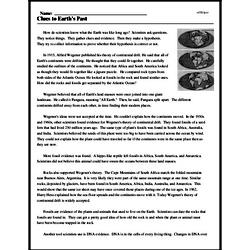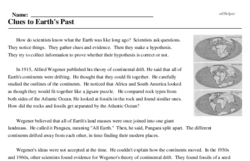Clues to Earth's Past
How do scientists know what the Earth was like long ago? Scientists ask questions. They notice things. They gather clues and evidence. Then they make a hypothesis. They try to collect information to prove whether their hypothesis is correct or not.
In 1915, Alfred Wegener published his theory of continental drift. He said that all of Earth's continents were drifting. He thought that they could fit together. He carefully studied the outlines of the continents. He noticed that Africa and South America looked as though they would fit together like a jigsaw puzzle. He compared rock types from both sides of the Atlantic Ocean. He looked at fossils in the rock and found similar ones. How did the rocks and fossils get separated by the Atlantic Ocean?
Wegener believed that all of Earth's land masses were once joined into one giant landmass. He called it Pangaea, meaning "All Earth." Then, he said, Pangaea split apart. The different continents drifted away from each other, in time finding their modern places.




